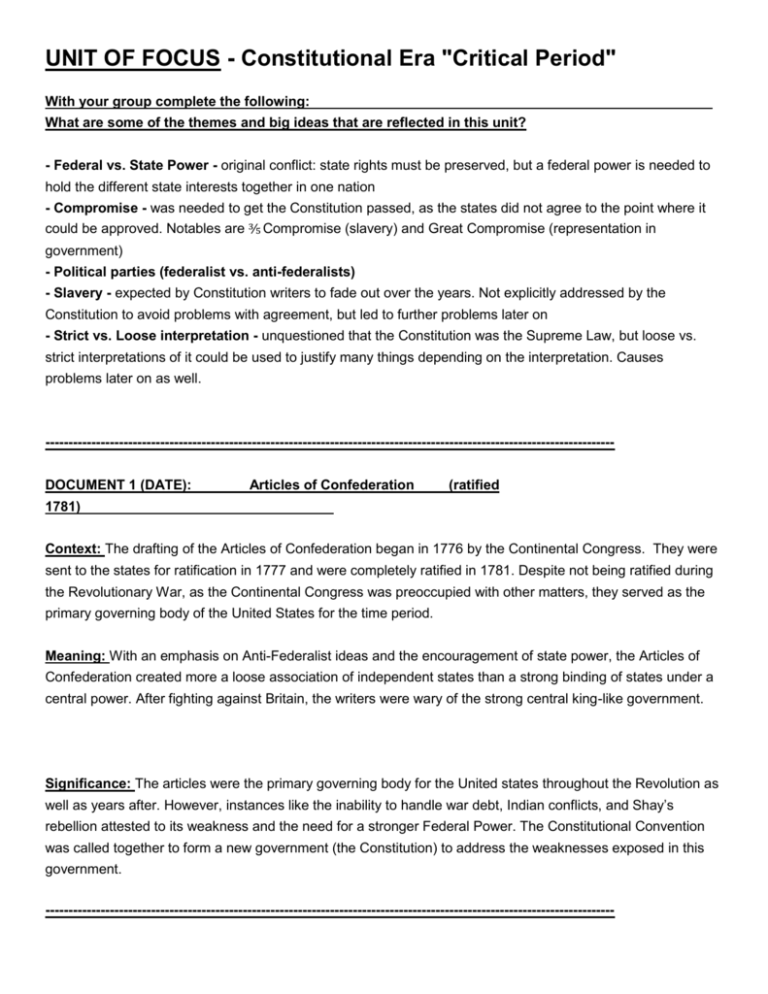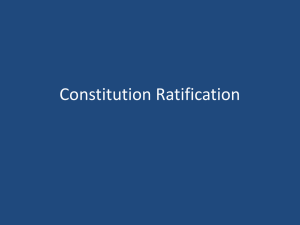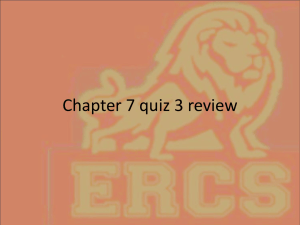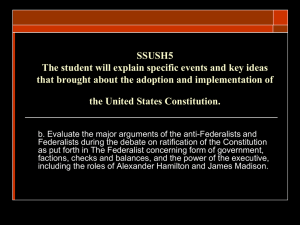UNIT OF FOCUS - Constitutional Era "Critical Period"
advertisement

UNIT OF FOCUS - Constitutional Era "Critical Period" With your group complete the following: What are some of the themes and big ideas that are reflected in this unit? - Federal vs. State Power - original conflict: state rights must be preserved, but a federal power is needed to hold the different state interests together in one nation - Compromise - was needed to get the Constitution passed, as the states did not agree to the point where it could be approved. Notables are ⅗ Compromise (slavery) and Great Compromise (representation in government) - Political parties (federalist vs. anti-federalists) - Slavery - expected by Constitution writers to fade out over the years. Not explicitly addressed by the Constitution to avoid problems with agreement, but led to further problems later on - Strict vs. Loose interpretation - unquestioned that the Constitution was the Supreme Law, but loose vs. strict interpretations of it could be used to justify many things depending on the interpretation. Causes problems later on as well. ---------------------------------------------------------------------------------------------------------------------------DOCUMENT 1 (DATE): Articles of Confederation (ratified 1781) Context: The drafting of the Articles of Confederation began in 1776 by the Continental Congress. They were sent to the states for ratification in 1777 and were completely ratified in 1781. Despite not being ratified during the Revolutionary War, as the Continental Congress was preoccupied with other matters, they served as the primary governing body of the United States for the time period. Meaning: With an emphasis on Anti-Federalist ideas and the encouragement of state power, the Articles of Confederation created more a loose association of independent states than a strong binding of states under a central power. After fighting against Britain, the writers were wary of the strong central king-like government. Significance: The articles were the primary governing body for the United states throughout the Revolution as well as years after. However, instances like the inability to handle war debt, Indian conflicts, and Shay’s rebellion attested to its weakness and the need for a stronger Federal Power. The Constitutional Convention was called together to form a new government (the Constitution) to address the weaknesses exposed in this government. ---------------------------------------------------------------------------------------------------------------------------- DOCUMENT 2 (DATE): Elastic Clause Context: The Constitution had submitted for ratification, and the Federalists were satisfied with the strength the national government received in the new government. However, the Anti-Federalists were fearful of the document, as it outlined the powers of the government, but did not protect the people from any expansion of power that could take away their rights. Thus, to ensure the ratification of the document, Federalists agreed that the Constitution would be amended to include a list of rights of the people that the government could not take away. Meaning: The First Amendment made to the Constitution guaranteed the right of the people to the freedom of speech, religion, and press. It meant people could not be punished for expression of opinion or belief Significance: The First Amendment was an important aspect throughout American history, particularly since many instances where the Constitution was violated was through the First Amendment. The Alien and Sedition Acts during Adams’ presidency silenced voices that opposed the Federal government and punished them for challenging any higher officials. Another instance of this violation was when Lincoln silenced press that opposed the Civil War in order to suppress any chaos and keep the Union orderly. He was heavily criticized for this violation. ---------------------------------------------------------------------------------------------------------------------------DOCUMENT 3 (DATE): ratified 1791 1st Amendment Context: Congress wished to see that the Constitution will protect the basic rights of the people, one of the main reasons why the colonies had originally rebelled against the British. As part of the Bill of Rights, the states had pressed for the amendments, which would protect the rights of the states to an extent from the federal government. Meaning: The people are granted freedom of religion, speech, press, and assembly - in addition, the government is prevented from making laws that threaten these fundamental freedoms. Significance: Essentially, this amendment, along with the supremacy clause, was meant to ensure that the government would never be able to threaten the fundamental rights of the people. By extension, it was one precaution that limited the federal government from becoming too powerful, yet depending on the interpreters of the Constitution, the First Amendment tended to be bypassed in times of war, such as with the Alien and Sedition Acts. ---------------------------------------------------------------------------------------------------------------------------DOCUMENT 4: 10th Amendment (ratified December 15, 1791) Context: With the creation of the new Constitution over the Articles of Confederation, it became evident that the stronger central government of Federalist ideology was triumphing over the state and people centered Anti- Federalists. However, to satisfy the remaining anti-federalists, the Bill of Rights (the first ten amendments), was added to the Constitution to preserve and protect the rights of the people from the excessive governmental power anti-Feds feared. At the time, many Federalists critics thought this unnecessary, but they went through with it, and states were eager to ratify it. Meaning: The Tenth Amendment states that powers not granted to the federal government by the Constitution, nor prohibited to the States, are reserved to the States or the people. Significance: The Tenth Amendment is significant in that it helps answer the question of which powers fall under which governmental (Federal vs State) jurisdiction, which had been less specific in the Constitution. It also allows states more power than as was stated in just the constitution alone. ---------------------------------------------------------------------------------------------------------------------------SEE ALSO: Elastic Clause Treaty of Ft. Stanwix Federalist papers 15 and 51. Land Ordinance 1785









